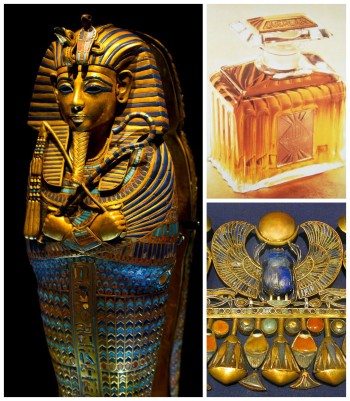
KingTutankhamun Sarcophagus Vintage Djedi Bottle and Jeweled scarab
Oh me, oh my do I ever feel privileged in smelling this marvelous piece of history. I have to admit this is one that has required extended study on my part as it is a perfume that isn’t one I can pull out and spray with reckless abandon. No, this one is a rarity that must be appreciated in a specific situation. I have only a precious small vial of DJEDI filled with the vintage EDT and every drop is sacred. It’s truly a treasure.
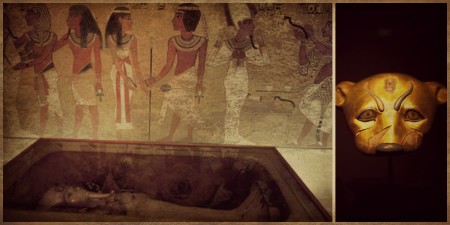
Tomb of King Tutankhamun 1923 (colorized) and gold masque
The perfume was created in 1926 by Jacques Guerlain from the inspiration of events in Egypt. At the time of its creation the world was enthralled with all things Egypt due to the discovery of the tomb of King Tutankhamun in 1923. The treasures that came from the tomb were as bright and shimmering as they were dark and mysterious. That fact alone was enough to get the gears turning in one’s brain. That said, the world was entranced in the wonder and the mystery.
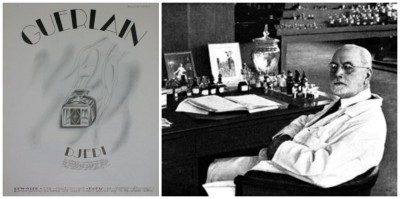
Vintage Guerlain DJEDI ad and Jaques Guerlain
Jacques was indeed no exception and set out to explore his fascination in perfume form. Coupled with his interest in Egypt, Jacques Guerlain wanted to make a new perfume to celebrate 100 years of the house of Guerlain. The result was touted as “the perfume of a century” and its name was Djedi (named after a mythical magician/prophet in Egyptian folklore). The perfume symbolized the marriage of modern with the resurrected ancient. It symbolism brings to mind rebirth and the grand scheme of the process. Here we are presented with a story told through scent drenched in symbolism.
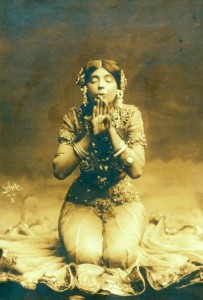
Ruth St Denis Dancer c 1910
The pyramid for Djedi to me is as complex as it is simple. While I understand it is meant to be a Chypre, it is definitely not what one would consider a textbook example of what the genre came to represent. The perfume begins with quick blast of Muguet and aldehydes which don’t come off floral at all – it’s quite masterful – well blended and hidden. In all fairness, this might be a bit different than was originally intended all those years ago.
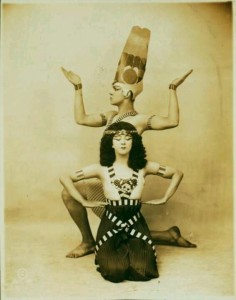
Ted Shawn and Ruth St. Denis in Egyptian Ballet, ca. 1910.
I believe the tiny bit I have has felt the effects of age, but the remnant of what it was is there. This simple fact could have been deliberate; a prospect I find very interesting. Might Jacques have taken this into account? I would not be one bit surprised if that were the case. That said, the choice of Muguet is interesting in that it symbolizes rebirth in some lines of thinking. That in turn goes right in line of everlasting life – a tenant of Egyptian belief. While its presence is made vaguely apparent, it is certainly not the focus. It’s just the beginning of the story…

Ferdinand Max Bredt Tutt'Art@
Shortly after the initial notes dissipate there is a hint of green, but not the typical green one might think about. This is almost unspoken as if designed to be a mere afterthought in the grand scheme. To me it serves as a function of representing the smell of life – vivid in its initial stages, but slowly, albeit quickly, fading as life moves towards an end. It’s not something that screams, it’s just there as it is – a matter of fact. All the while a demur iris dusted rose sits quietly observing it all pass by as it itself slowly dies, yet resects itself time after time.
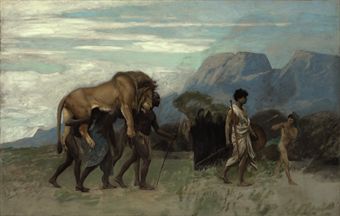
Jean Léon Gérôme (Vesoul 1824-Paris 1904) return from the lion hunt
Right from the initial application there are a couple things that are completely obvious. There are animals and there is grass. The animalic carnality here is represented by civet, musk, and castoreum. It is very interestingly done. I have in fact been musing about this for a solid two weeks as I dissected the perfume. Frankly, I have never come across something that even remotely matches the way this is put together. The civet is not all the stinkfest that many associate with the note. I must admit I found this a bit disappointing as I hoped it would be up front and center. Alas, it is not. I believe this is due in part to it being mixed with an ever so slight musk. The musk here is sweet and not real apparent. I can find no other way of describing the dichotomy, so I’ll just leave it at that. Yes, it has left me darn near speechless.
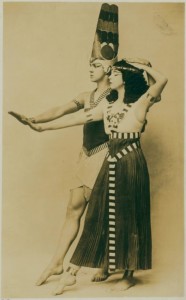
Ted Shawn and Ruth St. Denis in Egyptian Ballet, ca. 1910.
Of all the animalic aspects it’s the castoreum that is the most evident to me. Here it used for its leathery aspects, but I also dare say that it’s aspects as used in food are apparent. There is a certain buttery effect (almost gourmand) thing going on here that I was not expecting in the least. In the background there is the every so crafty vanilla note which adds to the depth and gives a syrupy effect. In a way I am not surprised at this as castoreum is used for a vanilla substitute in food and in flavoring in cigarettes. So, we do have vanilla ala Guerlain in there in a very clever way. But, moreover, what else do we have? It’s a symbol of the roaring twenties modernity in line with the then current events in Egypt. CLEVER! Yes, even back then, it was a brilliant marketing strategy.

Cleopatra's Barge Frederick Arthur Bridgman
Now, there is the grass. Here it is represented by the interesting subdued greenness that I mentioned earlier. It reminds me of the smell of a stem – like that of Muguet immediately after being picked. It also reminds me of reeds. Yes, reeds, like the sort that grow beside a pond on a creek/river bank. As in the kind that would be used to makes boats in ancient Egypt. The same boats used in funeral activities AND to transport one to the afterlife. Again, I think this was deliberate and quite brilliant. Here it is married to Vetiver that is presented with its more woody attributes in the forefront accompanied by oak moss and patchouli. Together they make a dry, yet once moist, aura. To me this makes total sense. The boats were made of reeds and wood, such as cedar from Lebanon. The same can be said of many furnishes used by the Egyptians). It’s interesting because through my research I don’t get an actual wood per se, but the idea of it is certainly present in the juxtaposition of notes between the vetiver and oak moss while patchouli holds it all together. Simply put, it marvelously interesting. Together they bring to mind the dryness of what is now Egypt, but also represents the Earthiness of the entire landscape that the Nile changes.
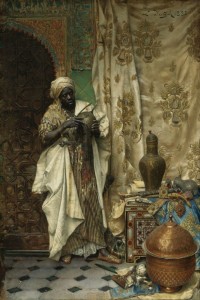
LUDWIG DEUTSCH The Inspection
The final stages of the perfume are where it gets the most interesting. Whilst it doesn’t really seem to progress, it does at the same time. Here is where little hints of spices come out and the syrupy nuances I mentioned earlier together. It brings to mind the glorious spices and rarities that may have been included in the treasures left in the tomb. I’ve heard it be said that the perfumes in the urns of the tomb retained their fragrance and when unearthed came back to life. There are balsams, resins, and spices that weave through the perfume in the most marvelous of ways. Every now and again there is a hint of cinnamon (most likely carnation or clove), then a bit fir, occasionally something myrrhish. There is an also a musty smokiness in the air, but not freshly burned smokiness. No, it’s like the remnant of incense that was burned long ago, but still present in the dust from thousands of years – no longer like a incense, but simply an integral part of all that was.
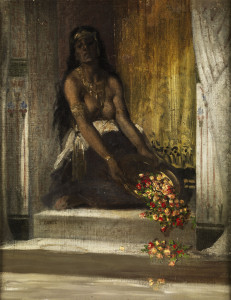
Alphonse Etienne Dinet Harem Woman
Still, the thing that strikes me the most is the syrupy effect. Yes, it’s still there in the dry down. In fact, it never ever left. It has prevailed from the second I put this precious liquid on my pulse points. It’s not overbearing, but it’s deep, dark, and lusciously decadent. It’s difficult to describe as anything more than “syrupy”. In fact, since I was at loss of exactly what to think, I wore it and presented it to people of all sexes and random ages that would have no idea what it was, it’s history, or anything about it whatsoever. The idea to do so was astonishing. Amazingly, I did not hear once it smelled old – nope, not once.
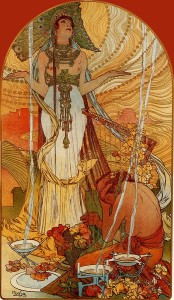
'Cleopatra', by Alphonse Mucha
What I have heard and agree with is….it reminded people of candy. Yes, candy. Most of them were at a loss of words as to what candy, but a few were brave enough to say what it most reminded them of. More than a few said it reminds them of butterscotch and cinnamon. Another said caramel corn. A couple others stated it reminded them of the Holidays. One said Spiced Bread Pudding. Well, now… this was certainly an interesting finding. Like a scientist, I was at once shocked as well as relieved that my finding was verified and confirmed. The expansion of “syrupy” into candy was very helpful …the revelation (that I really already had in my head) did nothing more than make Djedi that much more interesting to me. Whereas it historically went down as not fitting in with Guerlain at the time, it really actually did – in the future! It smells like it’s coming into its own NOW. Could this be prophetic? This is really, really fascinating. Let us keep in mind; it’s not far before the next century of its creation (only a decade till 2026!). Could it be that I have stumbled upon the revelation that it could now be considered something more than it was and Jacques is even more genius than I gave him credit for? Hmm, I maybe on to something here… In my eyes this was/is a pseudo Oriental Gourmand in Leather Chypre clothing – a clever trickster and master of deception in the most benign of ways (or is it?). Whatever it is, there is one thing that is for sure and I have to give him props for it. Monsieur Jacques, you were clever, clever, and CLEVER!
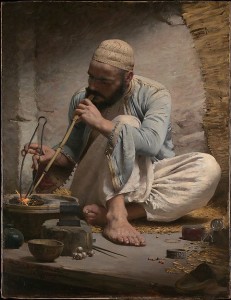
Charles Sprague Pearce’s Arab Jeweler
Wow. I’m simply flabbergasted by all this. Believe me, the review of this perfume has been one of the roughest I’ve ever had to comprehend, let alone try to explain to others. Djedi is truly like an enigma that can be explained, but in all actuality cannot be accurately interpreted. Thinking about it…it’s much less a perfume as it is a work of art! It really is masterful in a way of complete deception. It is and it isn’t. Like a magic trick. You see it, but you’re mystified as to what you are beholding. You know you experienced it, but how on Earth did this happen? It can be a matter of fact, yet it still can be mystical as somethings cannot readily be easily explained. Way to go, Djedi!
I’m sure that formulations of this have changed over the years. I have not smelled the edition from the 1990’s, but I am curious as to what it may smell like. Also, I have not smelled the recreated version that Thierry Wasser recently did with Guerlain. The thing is, even if it was masterfully recreated in either instance; will it take another 100 years for it to come into its own? One would be hard pressed to say as the process of nature is as magic as it is natural. One never knows what the true circumstances might bring. I do know one thing, if this could come back for the masses at a reasonable price, this could be a massive resurrection from the dead. Yes indeed, miraculous. Let’s see what the future holds.
Notes: Civet, Vetiver, Musk, Leather, Oakmoss, Patchouli, Rose
–Aaron Potterman, Contributor and Vintage Perfume Expert
MC Art Director: Orientalist Art and 20s "Modern" Egypt inspired costume dance. I just hope I did Aaron's review justice
Thanks to Diane at The Perfumed Court we have a worldwide draw of 1 ml of the Original 1926 Eau de Toilette for a registered (please make sure you are registered). To be eligible please be sure you subscribe to The Perfumed Court Newsletter as well. Leave a comment with why you would like to win a vial of one of the rarest vintage perfumes by Guerlain, where you live and what you enjoyed about Aaron’s in depth review by January 6, 2016.
We announce the winners on our Face Book page so be sure to Like Cafleurebon and use our RSS option…or your dream prize will just be spilled perfume
